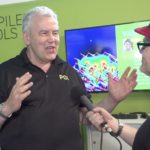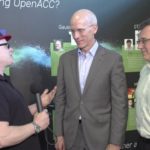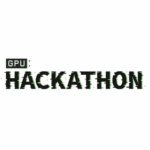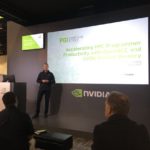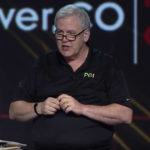Over at the University of Delaware, Julie Stewart writes that assistant professor Sunita Chandrasekaran has received an NSF grant to develop frameworks to adapt code for GPU supercomputers. She is working with complex patterns known as wavefronts, which are commonly found in scientific codes used in analyzing the flow of neutrons in a nuclear reactor, extracting patterns from biomedical data or predicting atmospheric patterns.
Video: Introduction to OpenACC
Vasileios Karakasis from CSCS gave this talk at the the Directive Based GPU Programming Workshop. “Directives-based programming facilitates the task of parallelizing your application by letting you focus on its parallel logic rather than on the very details and the low-level intricacies of the GPU architecture. In this course, we will introduce the OpenACC programming paradigms for the GPU. We will cover the parallel execution model and how it can be used to leverage parallelism, the memory model and how this differs from the classic CPU paradigm.”
Porting HPC Codes with Directives and OpenACC
In this video from ISC 2018, Michael Wolfe from OpenACC.org describes how scientists can port their code to accelerated computing. “OpenACC is a user-driven directive-based performance-portable parallel programming model designed for scientists and engineers interested in porting their codes to a wide-variety of heterogeneous HPC hardware platforms and architectures with significantly less programming effort than required with a low-level model.”
OpenACC Helps Scientists Port their code at the Center for Application Readiness (CARR)
In this video, Jack Wells from the Oak Ridge Leadership Computing Facility and Duncan Poole from NVIDIA describe how OpenACC enabled them to port their codes to the new Summit supercomputer. “In preparation for next-generation supercomputer Summit, the Oak Ridge Leadership Computing Facility (OLCF) selected 13 partnership projects into its Center for Accelerated Application Readiness (CAAR) program. A collaborative effort of application development teams and staff from the OLCF Scientific Computing group, CAAR is focused on redesigning, porting, and optimizing application codes for Summit’s hybrid CPU–GPU architecture.”
Call for Applications: NCSA GPU Hackathon in September
NCSA is now accepting team applications for the Blue Waters GPU Hackathon. This event will take place September 10-14, 2018 in Illinois. “General-purpose Graphics Processing Units (GPGPUs) potentially offer exceptionally high memory bandwidth and performance for a wide range of applications. A challenge in utilizing such accelerators has been learning how to program them. These hackathons are intended to help overcome this challenge for new GPU programmers and also to help existing GPU programmers to further optimize their applications – a great opportunity for graduate students and postdocs. Any and all GPU programming paradigms are welcome.”
Accelerating HPC Applications on NVIDIA GPUs with OpenACC
Doug Miles from NVIDIA gave this talk at the Stanford HPC Conference. “This talk will include an introduction to the OpenACC programming model, provide examples of its use in a number of production applications, explain how OpenACC and CUDA Unified Memory working together can dramatically simplify GPU programming, and close with a few thoughts on OpenACC future directions.”
Accelerating HPC Programmer Productivity with OpenACC and CUDA Unified Memory
Doug Miles from NVIDIA gave this talk at SC17. “CUDA Unified Memory for NVIDIA Tesla GPUs offers programmers a unified view of memory on GPU-accelerated compute nodes. The CPUs can access GPU high-bandwidth memory directly, the GPUs can access CPU main memory directly, and memory pages migrate automatically between the two when the CUDA Unified Memory manager determines it is performance-profitable. PGI OpenACC compilers now leverage this capability on allocatable data to dramatically simplify parallelization and incremental optimization of HPC applications for GPUs.”
Building a GPU-enabled and Performance-portable Global Cloud-resolving Atmospheric Model
Richard Loft from NCAR gave this talk at the NVIDIA booth at SC17. “The objectives of NCAR’s exploration of accelerator architectures for high performance computing in recent years has been to 1) speed up the rate of code optimization and porting and 2) understand how to achieve performance portability on codes in the most economical and affordable way.
Michael Wolfe Presents: Why Iteration Space Tiling?
In this Invited Talk from SC17, Michael Wolfe from NVIDIA presents: Why Iteration Space Tiling? The talk is based on his noted paper, which won the SC17 Test of Time Award. “Tiling is well-known and has been included in many compilers and code transformation systems. The talk will explore the basic contribution of the SC1989 paper to the current state of iteration space tiling.”
Video: OpenACC Eases GPU Programming for HPC at SC17
In this video from SC17, Sunita Chandrasekaran from OpenACC.org and Stan Posey from NVIDIA describe how OpenACC eases GPU programming for HPC. “At SC17, OpenACC.org announced milestones highlighting OpenACC’s broad adoption in weather and climate models that simulate the Earth’s atmosphere, including one of this year’s Gordon Bell finalist. Additionally, the organization announced their hackathon momentum and the new OpenACC 2.6 specification.”



